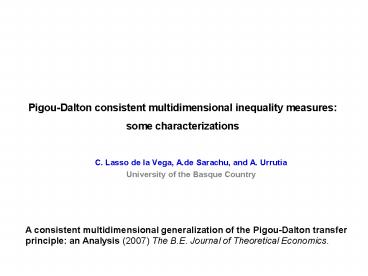Pigou-Dalton consistent multidimensional inequality measures: some characterizations - PowerPoint PPT Presentation
Title:
Pigou-Dalton consistent multidimensional inequality measures: some characterizations
Description:
Pigou-Dalton consistent multidimensional inequality measures: some characterizations C. Lasso de la Vega, A.de Sarachu, and A. Urrutia University of the Basque Country – PowerPoint PPT presentation
Number of Views:58
Avg rating:3.0/5.0
Title: Pigou-Dalton consistent multidimensional inequality measures: some characterizations
1
Pigou-Dalton consistent multidimensional
inequality measures some characterizations
- C. Lasso de la Vega, A.de Sarachu, and A. Urrutia
- University of the Basque Country
A consistent multidimensional generalization of
the Pigou-Dalton transfer principle an Analysis
(2007) The B.E. Journal of Theoretical Economics.
2
PIGOU-DALTON CONSISTENT MULTIDIMENSIONAL
INEQUALITY MEASURES
- THE OUTLINE
- 1. Motivation
- 2. Some basic notions about
- The Pigou-Dalton transfer principle in the
one-dimensional framework - The Uniform Majorization
- 3. The proposal of a proper generalization of the
Pigou-Dalton principle - The Pigou-Dalton bundle principle
- Characterizations of classes of aggregative
multidimensional inequality measures consistent
with the Pigou Dalton bundle principle - 5. Some concluding remarks
3
1. MOTIVATION
How might multidimensional distributions be
compared in order to say that one distribution is
more equal than another ?
One dimensional Context Pigou-Dalton transfer
principle
Multidimensional Context Uniform majorization,
UM
According to the Pigou-Dalton transfer principle
inequality is bound to diminish. These two
distributions can not be compared with UM.
4
2. BASIC NOTIONS about the Pigou-Dalton principle
in the unidimensional setting
Single attribute
5
2. BASIC NOTIONS about the Pigou-Dalton transfer
principle in the unidimensional setting
Pigou-Dalton transfer principle if Y can be
obtained from X by a finite sequence of
Pigou-Dalton progressive transfers or
equivalently If Y BX, where B is a
bistochastic matrix
6
2. BASIC NOTIONS ABOUT THE UNIFORM MAJORIZATION
(Kolm, (1977) Marshall and Olkin, (1979))
Uniform majorization if
Y BX where B is a bistochastic matrix
income
income health education
7
2. BASIC NOTIONS ABOUT THE UNIFORM MAJORIZATION
BX
8
2. BASIC NOTIONS ABOUT THE UNIFORM MAJORIZATION
Some difficulties arise with UM 1) The reasons
for transferring all attributes in the same
proportions are not clear. 2) It is not
necessarily the case that each attribute can be
considered as transferable, for instance for
educational attainment or health status. 3) This
criterion warrants transfers of different
directions for different attributes, and is not
limited to cases when one individual is richer
than another, being not obvious that these
transfers are inequality reducing.
9
3. THE PIGOU-DALTON BUNDLE PRINCIPLE
Who is the richer person? If a person has more
of all attributes than another, we can
unambiguously consider this person richer than
the second.
Fleurbaey and Trannoy , Soc Choice Welfare (2003)
The Pigou-Dalton Bundle principle, PD, requires
that whenever an individual i is richer than
another j, a transfer of at least part of one
attribute from individual i to j that preserves
the order, decreases inequality.
This principle gets over the previous
difficulties 1) It is not necessary to transfer
all attributes in the same proportions. 2) the
attributes which are considered as transferable
can be selected. 3) It takes into consideration
who is the richer and who is the poorer.
10
4. OUR CHARACTERIZATION RESULTS
- Multidimensional aggregative inequality measures
consistent with Pigou-Dalton Bundle principle,
from two different approaches - The characterization of social evaluation
functions consistent with the Pigou-Dalton bundle
principle, and - the derivation of inequality measures from them
afterwards. - (following the Atkinson, Kolm Pollak
approaches). - The derivation of the inequality measures
consistent with the Pigou-Dalton bundle
principle, without explicitly specifying the
underlying social evaluation functions .
11
4. OUR CHARACTERIZATION RESULTS
Following Tsui (1995)
Multidimensional generalization of the Atkinson
family
12
4. OUR CHARACTERIZATION RESULTS
Following Tsui (1995)
MULTIDIMENSIONAL GENERALIZATION OF THE
KOLM-POLLAK FAMILY
13
4. OUR CHARACTERIZATION RESULTS
Following Tsui (1999)
MULTIDIMENSIONAL GENERALIZATION OF THE
GENERALIZED ENTROPY FAMILY
14
4. OUR CHARACTERIZATION RESULTS
- There exist measures in our family that dont
belong to the family derived by Tsui, that is,
measures fullfilling PD and not UM, and vice
versa - There exist measures in the family derived by
Tsui that dont belong to our family, that is,
measures fullfilling UM and not PD - There exist measures belonging to both families,
that is, measures fullfilling PD and UM.
15
5. FUTURE RESEARCH
v
A related area of research The characterization
of all multidimensional inequality measures that
are Pigou-Dalton Bundle consistent. (without
imposing the aggregative principle).
16
- This paper
- provides a greater understanding of the
Pigou-Dalton transfer principle in the
multidimensional framework - represents a step forward in the derivation of
multidimensional inequality measures by imposing
some convenient properties.





























